Scoliosis
Scoliosis is an abnormal curving of the spine. Your spine is your backbone. It runs straight down your back. Everyone's spine naturally curves a bit. But people with scoliosis have a spine that curves too much. The spine might look like the letter C or S.
Scoliosis - Animation
Remember when you were a kid, and every year you had to line up in front of the school nurse and bend over so she could check your spine? What she was looking for was scoliosis, or a curved spine. Sometimes babies are born with a curved spine, because bones called vertebrae in their spine didn't form correctly in the womb. Others develop scoliosis because of conditions that weaken the muscles or lead to paralysis, like cerebral palsy, muscular dystrophy, spina bifida, or polio. Sometimes doctors can't find a cause for scoliosis. So, what are the signs your child has scoliosis? You might notice that one shoulder is higher than the other, or the pelvis is tilted. If the spine is only a little bit curved, you may not spot any differences in your child's body. But sometimes the abnormal curve can cause backaches. Your doctor will diagnose scoliosis with the same test school nurses use, by having your child bend over and looking for a curve in the spine. A nervous system exam can find problems with strength or reflexes. Imaging tests such as x-rays or an MRI will give the doctor a better view of your child's spine. Now, if scoliosis is diagnosed, you probably ask, how is it treated? Children and teens who don't have much of a curve in their spine may not need to be treated. They should just be checked about once every 6 months to make sure the curve hasn't gotten worse. Kids with more severe scoliosis may need a brace to press the spine straight. Bracing only works for certain types of scoliosis, though. Really dramatic curves usually need surgery to fuse the bones in the spine together. The bones are held in place with hooks and screws until they heal together. The biggest impact of scoliosis is usually on a child's appearance. Having a curved spine can be embarrassing, and it can help for kids to get emotional support while they are being treated. When scoliosis is minor enough to be treated with a brace or surgery, kids usually do very well. A more severely curved spine is likely to get worse after the child stops growing. Kids with severe scoliosis may develop breathing problems and low back pain as adults. Because middle schools screen students for scoliosis, it's caught much earlier than it used to be, offering kids a better chance for treatment. If you think your child might have scoliosis, call your doctor.
Causes
Most of the time, the cause of scoliosis is unknown. This is called idiopathic scoliosis. It is the most common type. It is grouped by age.
- In children age 3 and younger, it is called infantile scoliosis.
- In children age 4 through 10, it is called juvenile scoliosis.
- In children age 11 through 18, it is called adolescent scoliosis.
Scoliosis most often affects girls. Some people are more likely to have curving of the spine. Curving generally gets worse during a growth spurt.
Other types of scoliosis are:
- Congenital scoliosis: This type of scoliosis is present at birth. It occurs when the baby's ribs or spine bones do not form properly.
- Neuromuscular scoliosis: This type is caused by a nervous system problem that affects the muscles. Problems can include cerebral palsy, muscular dystrophy, spina bifida, and polio.
Cerebral palsy
Cerebral palsy (CP) is a group of disorders that involve the brain. This affects nervous system functions, such as movement, learning, hearing, seei...
 ImageRead Article Now Book Mark Article
ImageRead Article Now Book Mark ArticleMuscular dystrophy
Muscular dystrophy (MD) is a group of inherited disorders that cause muscle weakness and loss of muscle tissue, which get worse over time.
 ImageRead Article Now Book Mark Article
ImageRead Article Now Book Mark ArticlePolio
Polio is a viral disease that can affect nerves and can lead to partial or full paralysis. The medical name for polio is poliomyelitis.
 ImageRead Article Now Book Mark Article
ImageRead Article Now Book Mark Article
Symptoms
Most often, there are no symptoms.
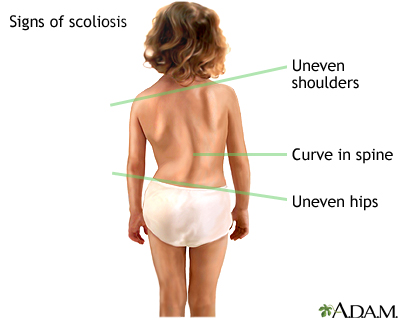
Signs of scoliosis
Scoliosis may be suspected when one shoulder appears to be higher than the other, there is a curvature in the spine, or the pelvis appears to be tilted. The treatment of scoliosis can involve the use of a brace or surgery. Treatment is determined by the cause of the scoliosis, the size and location of the curve, and the stage of bone growth of the patient.
If there are symptoms, they may include:
- Backache or low-back pain that goes down the legs
- Weakness or tired feeling in the spine after sitting or standing for a long time
- Uneven hips or shoulders (one shoulder may be higher than the other)
- Shoulder pain
- Spine curves more to one side
- Difficulty with breathing or sitting
Exams and Tests
Your health care provider will perform a physical exam. You will be asked to bend forward. This makes your spine easier to see. It may be hard to see changes in the early stages of scoliosis.
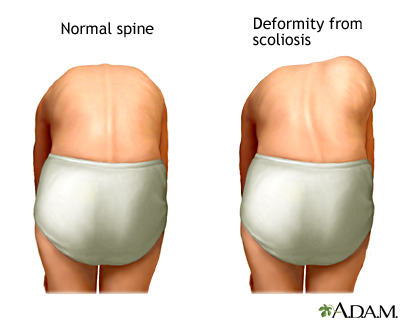
Forward bend test
The forward bend test is a test used most often in schools and doctors offices to screen for scoliosis. During the test, the child bends forward with the feet together and knees straight while dangling the arms. Any imbalances in the rib cage or other deformities along the back could be a sign of scoliosis.
The exam may show:
- One shoulder is higher than the other
- The pelvis is tilted
X-rays of the spine are done. X-rays are important because the actual curving of the spine may be worse than what your doctor can see during an exam.
Other tests may include:
- Spinal curve measurement (scoliometer screening)
- X-rays of the spine to see how flexible the curvature is
- MRI of the spine
MRI
A magnetic resonance imaging (MRI) scan is an imaging test that uses powerful magnets and radio waves to create pictures of the body. It does not us...
 ImageRead Article Now Book Mark Article
ImageRead Article Now Book Mark Article - CT scan of the spine to look at the bony changes
CT scan
A computed tomography (CT) scan is an imaging method that uses x-rays to create pictures of cross-sections of the body. Related tests include:Abdomin...
 ImageRead Article Now Book Mark Article
ImageRead Article Now Book Mark Article
Treatment
Treatment depends on many things:
- The cause of scoliosis
- Where the curve is in your spine
- How big the curve is
- If your body is still growing
Most people with idiopathic scoliosis do not need treatment. But you should still be checked by your provider about every 6 months.
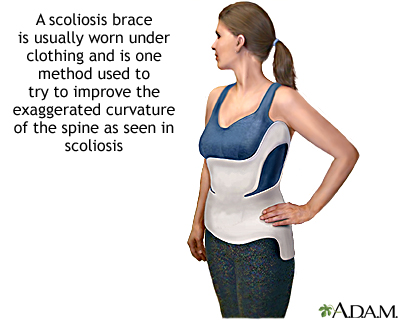
Scoliosis brace
One type of treatment for scoliosis is the use of a brace. The brace works by exerting pressure on the back and ribs to push the spine in a straighter position. The brace usually fits snugly around the torso and can come in many styles. In a child who is still growing, bracing is usually recommended to help slow the progression of the curve. The brace is usually worn full-time until the growth of the bones has stopped.
If you are still growing, your provider might recommend a back brace. A back brace prevents further curving. There are many different types of braces. What kind you get depends on the size and location of your curve. Your provider will pick the best one for you and show you how to use it. Back braces can be adjusted as you grow.
Back braces work best in people over age 10 with continued growing potential. Braces do not work for those with congenital or neuromuscular scoliosis.
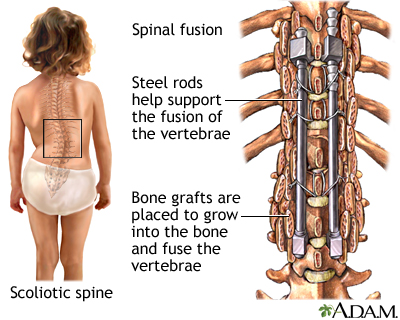
Spinal fusion
Depending upon the severity and responsiveness to other treatment surgery may be recommended for the scoliosis. Surgical correction involves correcting the curve (although not all the way) and fusing the bones in the curve together. Bone grafts are laid across the exposed surface of each vertebra. These grafts will regenerate, grow into the bone, and fuse the vertebrae together. The bones are held in place with one or two metal rods held down with hooks and screws, which also helps to support the fusion of the vertebrae.
You may need surgery if the spine curve is severe or getting worse very quickly.
Surgery
Scoliosis surgery repairs abnormal curving of the spine (scoliosis). The goal is to safely straighten your child's spine and align your child's shou...
Read Article Now Book Mark ArticleSurgery involves correcting the curve as much as possible:
- Surgery is done with a cut through the back, belly area, or beneath the ribs.
- The spine bones are held in place with 1 or 2 metal rods. The rods are held down with hooks and screws until the bone heals together.
- After surgery, you may need to wear a brace for a while to keep the spine stable.
Scoliosis treatment may also include:
- Emotional support: Some children, especially teens, may be self-conscious when using a back brace.
- Physical therapy and other specialists to help explain the treatments and make sure the brace fits correctly.
Support Groups
Seek support and more information from organizations that specialize in scoliosis.
Organizations that specialize in scolio...
The following organizations are good resources for information on scoliosis:American Academy of Orthopaedic Surgeons -- orthoinfo. aaos. org/en/disea...

Outlook (Prognosis)
How well a person with scoliosis does depends on the type, cause, and severity of the curve. The more severe the curving, the more likely it will get worse after the child stops growing.
People with mild scoliosis do well with braces. They usually do not have long-term problems. Back pain may be more likely when the person gets older.
The outlook for those with neuromuscular or congenital scoliosis varies. They may have another serious disorder, such as cerebral palsy or muscular dystrophy, so their goals of treatment may be much different. Often, the goal of surgery is simply to allow a child to be able to walk more properly or sit upright in a wheelchair.
Congenital scoliosis is difficult to treat and usually requires many surgeries.
Possible Complications
Complications of scoliosis can include:
- Breathing problems (in severe scoliosis)
- Low back pain
- Lower self-esteem
- Persistent pain if there is wear and tear of the spine bones
- Spinal infection after surgery
- Spine or nerve damage from an uncorrected curve or spinal surgery
- Leakage of spinal fluid
When to Contact a Medical Professional
Contact your provider if you suspect your child may have scoliosis.
Prevention
Routine scoliosis screening is now done in middle schools. Such screening has helped detect early scoliosis in many children. Back and abdominal muscle strengthening can help stabilize the curvature.
Reviewed By
C. Benjamin Ma, MD, Professor, Chief, Sports Medicine and Shoulder Service, UCSF Department of Orthopaedic Surgery, San Francisco, CA. Also reviewed by David C. Dugdale, MD, Medical Director, Brenda Conaway, Editorial Director, and the A.D.A.M. Editorial team.
Buell TJ, Lark R, Smith JS, Shaffrey CI. An approach for treatment of complex pediatric spinal deformity. In: Steinmetz MP, Berven SH, Benzel EC, eds. Benzel's Spine Surgery: Techniques, Complication Avoidance, and Management. 5th ed. Philadelphia, PA: Elsevier; 2022:chap 143.
Mistovich RJ, Spiegel DA. The spine. In: Kliegman RM, St. Geme JW, Blum NJ, Shah SS, Tasker RC, Wilson KM, eds. Nelson Textbook of Pediatrics. 21st ed. Philadelphia, PA: Elsevier; 2020:chap 699.
Negrini S, Di Felice F, Donzelli S, Zaina F. Scoliosis and kyphosis. In: Frontera WR, Silver JK, Rizzo TD Jr, eds. Essentials of Physical Medicine and Rehabilitation: Musculoskeletal Disorders, Pain, and Rehabilitation. 4th ed. Philadelphia, PA: Elsevier; 2019:chap 153.




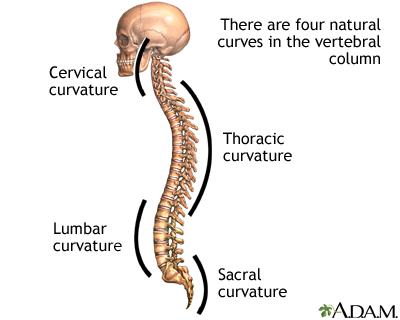
 All rights reserved.
All rights reserved.